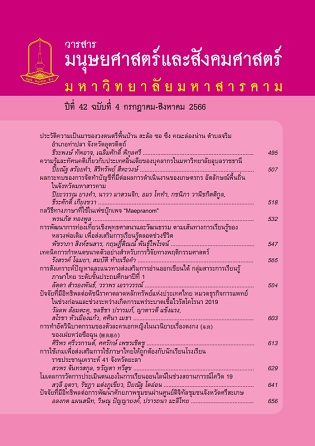เทคนิคการกำหนดขนาดตัวอย่างสำหรับการวิจัยทางพฤติกรรมศาสตร์
Main Article Content
บทคัดย่อ
บทความนี้มีจุดประสงค์ที่สำ คัญคือ (1) เพื่อให้ผู้อ่านได้รู้จักและทำ ความเข้าใจเกี่ยวกับเทคนิคการกำหนดขนาดตัวอย่างของการวิจัยทางพฤติกรรมศาสตร์ (2) เพื่อให้ผู้อ่านได้เห็นแนวทางวิธีการกำ หนดขนาดตัวอย่างของการวิจัยแบบคลาสสิก และ (3) เพื่อให้ผู้อ่านได้เห็นแนวทางวิธีการกำหนดขนาดตัวอย่าของการวิจัยด้วยโปรแกรมการคำ นวณขนาดตัวอย่างออนไลน์ บทความนี้ผู้เขียนใช้วิธีการสังเคราะห์ (synthesis) เอกสารทางวิชาการ หนังสือ ตำราและบทความที่ว่าด้วยการกำ หนดขนาดตัวอย่างของการวิจัยทางพฤติกรรมศาสตร์ โดยได้นำ เสนอแนวคิดว่าด้วยการกำ หนดขนาดตัวอย่างของการวิจัยทางพฤติกรรมศาสตร์ วิธีการกำ หนดขนาดตัวอย่างจากสูตร จากตารางที่ และจากโปรแกรมการคำนวณขนาดตัวอย่างออนไลน์ ของสถาบันต่างๆ และการกำหนดขนาดตัวอย่างสำหรับการวิจัยที่ใช้เทคนิคการวิเคราะห์ทางสถิติที่อาศัยจำ นวนตัวอย่างขนาดใหญ่ ได้แก่ การวิเคราะห์องค์ประกอบ (factor analysis)และการวิเคราะห์แบบจำลองสมการความสัมพันธ์โครงสร้างเชิงเส้น (structural equation modeling:SEM) ในตอนท้ายเป็นการสรุปและการให้ข้อเสนอในการประยุกต์ใช้เพื่อให้ผู้อ่านได้พิจารณานำ ไปใช้ในการดำ เนินการวิจัย และให้การวิจัยมีคุณภาพมีความน่าเชื่อถือ ตลอดจนพัฒนาองค์ความรู้ทางด้านวิจัยให้เพิ่มพูนมากยิ่งขึ้น
Article Details
เอกสารอ้างอิง
Ahn, C., Heo, M., & Zhang, S. (2015). Sample size calculations for clustered and longitudinal outcomes in clinical research. CRC Press.
Bentler, P. M., & Yuan, K.-H. (1999). Structural equation modeling with small samples: Test statistics. Multivariate Behavioral Research, 34 (2), 181- 197.
Campbell, M. J., Machin, D., Tan, S. B., & Tan, S. H. (2018). Sample size tables for clinical, laboratory and epidemiology studies (4th ed). John Wiley & Sons Ltd.
Clinical & Translational Science Institute. (2023). Sample size calculators. Clinical Research Program at UCSF.
Cochran, W. G. (1977). Sampling techniques. John Wiley and Sons, Inc.
Cozby, P. C., & Bates, S. C. (2018). Methods in behavioral research. McGraw-Hill Education.
Creative Research Systems. (2023). Sample size calculator. Creative Research Systems. website.
Christensen, L. B., Johnson, R. B., & Turner, L. A. (2014). Research methods, design, and analysis. Pearson International Publishing.
Dattalo, P. (2008). Determining sample size balancing power, precision, and practicality. Oxford University Press.
Fielding, N. (2017). The sage handbook of online research methods (2nd ed). SAGE Publications Ltd.
Gravetter, F. J. (2018). Research methods for the behavioral sciences. Cengage Learning.
Gravetter, F., Forzano, L-A., & Rakow, T. (2021). Research methods for the behavioural sciences. Cengage Learning EMEA.
Gravetter, F. J., & Forzano, L. B. (2011). Research methods for the behavioral sciences (4th ed). Cengage Learning.
Hair, J. F., Black, W. C., Babin, B. J., & Anderson, R. E. (2019). Multivariate data analysis (8th ed). Cengage Learning.
Härdle, W. K., & Simar, L. (2019). Applied multivariate statistical analysis (5th ed). Springer International Publishing.
Israel, G. D. (1992). Determining sample size. University of Florida Cooperative Extension Service, Institute of Food and Agriculture Sciences.
Kieser, M. (2020). Methods and applications of sample size calculation and recalculation in clinical trials. Springer.
Krejcie, R.V., & Morgan, D. W. (1970). Determining sample size for research activities. Educational and Psychological Measurement.
Ledford, J. R. (2018). Single case research methodology applications in special education and behavioral sciences. Routledge.
Leavy, P. (2023). Research design: Quantitative, qualitative, mixed methods, arts-based, and community-based participatory research approaches (2th ed). The Guilford Press.
Maple Tech International LLC. (2023). Sample size calculator. Maple Tech International LLC operates the calculator.net. https://www.calculator.net/sample-size-calculator.html
Patten, M. L, & Newhart, M. (2018). Understanding research methods. Taylor and Francis.
Pitard, F. R. (2019). Theory of sampling and sampling practice (3rd ed). CRC Press.
Privitera, G. J. (2016). Research methods for the behavioral sciences (2nd ed). Sage Publications, Inc.
Odeh, R. E., & Fox, M. (2020). Sample size choice charts for experiments with linear models. CRC Press.
Qualtrics. (2023). Sample size calculator. customer experience management (CXM). https://www.qualtrics.com/blog/calculating-sample-size/
Raosoft. (2023). Sample size calculator. Raosoft, International Corporation.
Rosei, F., & Johnston, T. (2005). Survey sampling: Theory and methods. CRC Press.
Schoot, R., & Miočević, M. (2020). Small sample size solutions a guide for applied researchers and practitioners. Routledge.
Tabachnick, B. G., & Fidell, L. S. (2007). Using multivariate statistics (5th ed). Pearson International Publishing.
Tabachnick, B. G. & Fidell, L. S. (2012). Using multivariate statistics (6th ed). Pearson International Publishing.
Tabachnick, B. G. & Fidell, L. S. (2014). Using multivariate statistics. Pearson International Publishing.
Tabachnick, B. G., Fidell, L. S., & Ullman, J. B. (2018). Using multivariate statistics (7th ed). Pearson International Publishing.
The SAS Technical Team Writers. (2004). Getting started with the SAS power and sample size application. SAS Institute Inc.
Verma, J. P., & Verma, P. (2020). Determining sample size and power in research studies a manual for researchers. Springer Singapore.
Yamane, T. (1967). Elementary sampling theory. Prentice-Hall.


